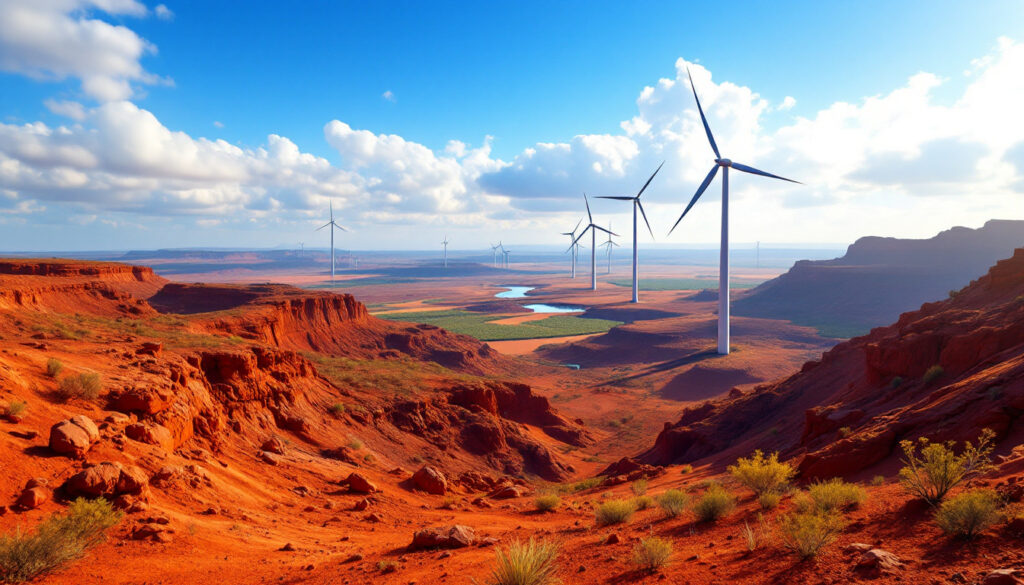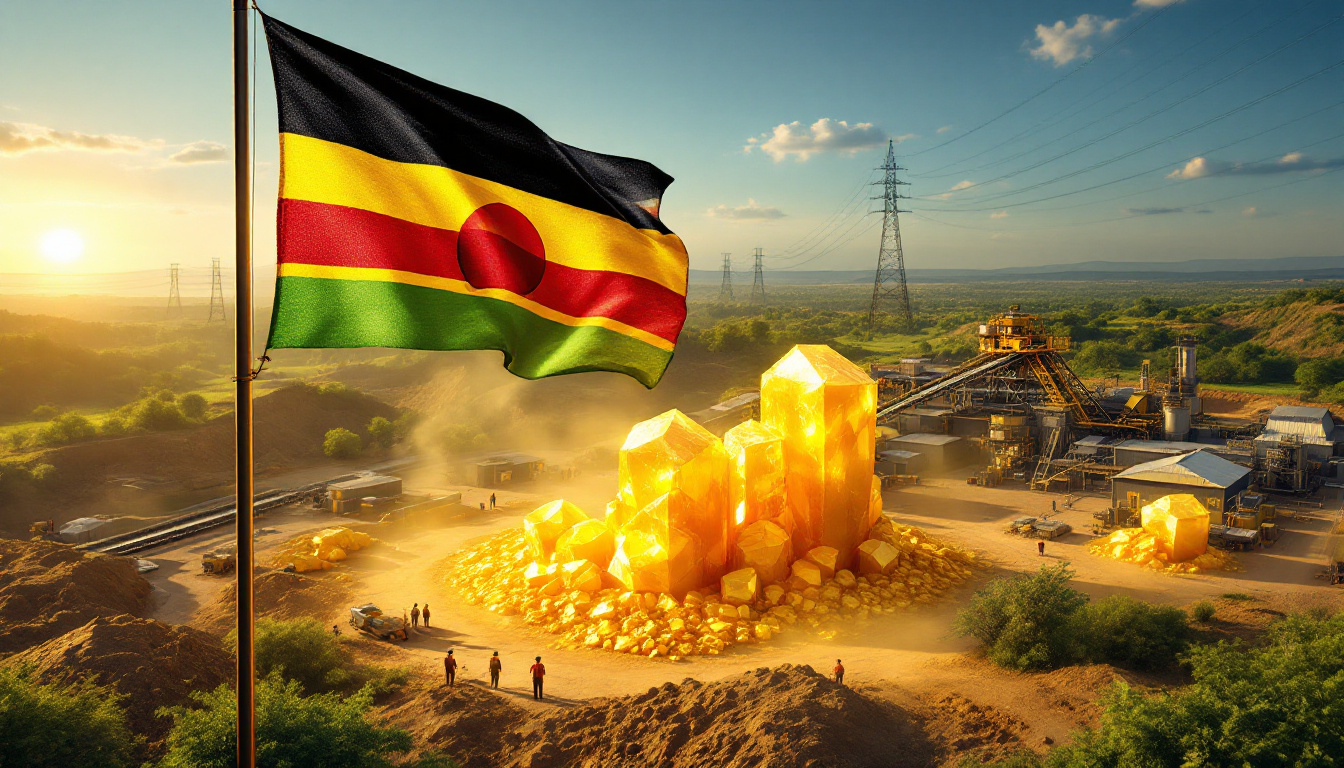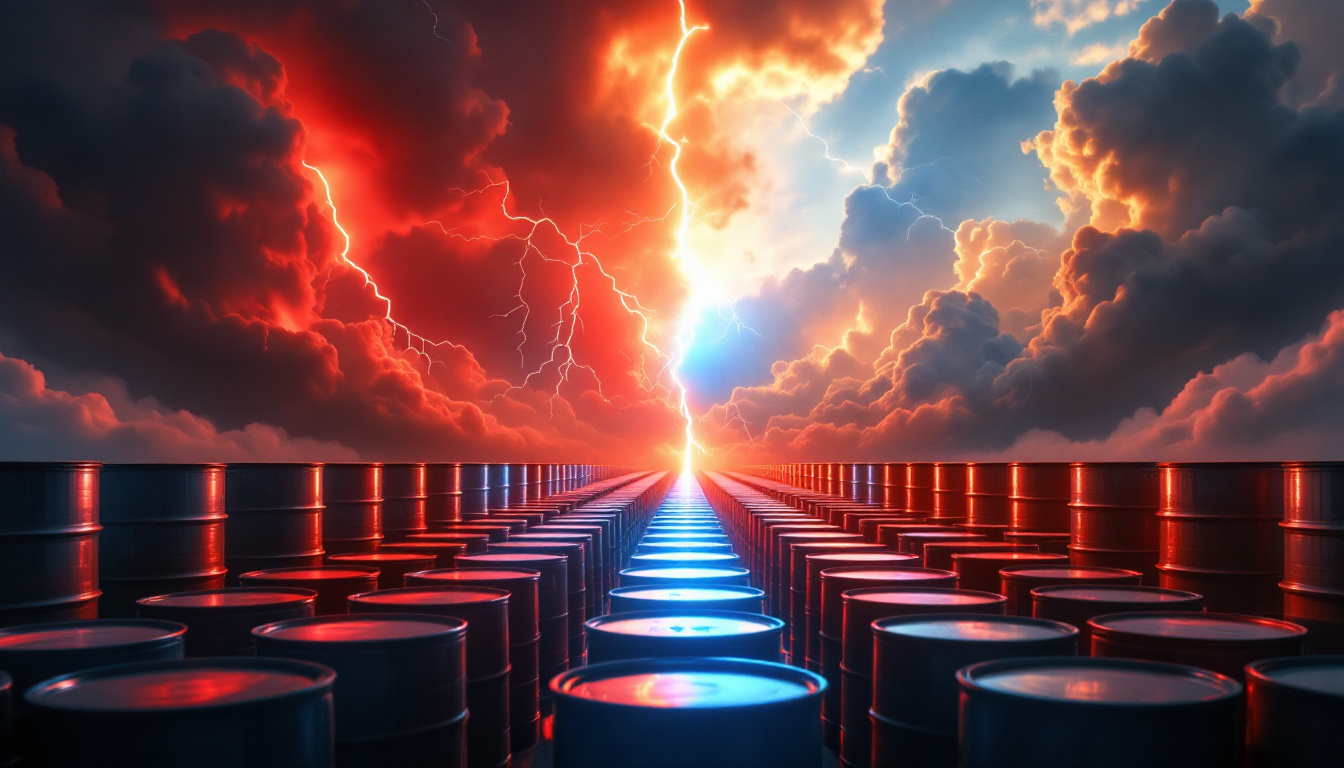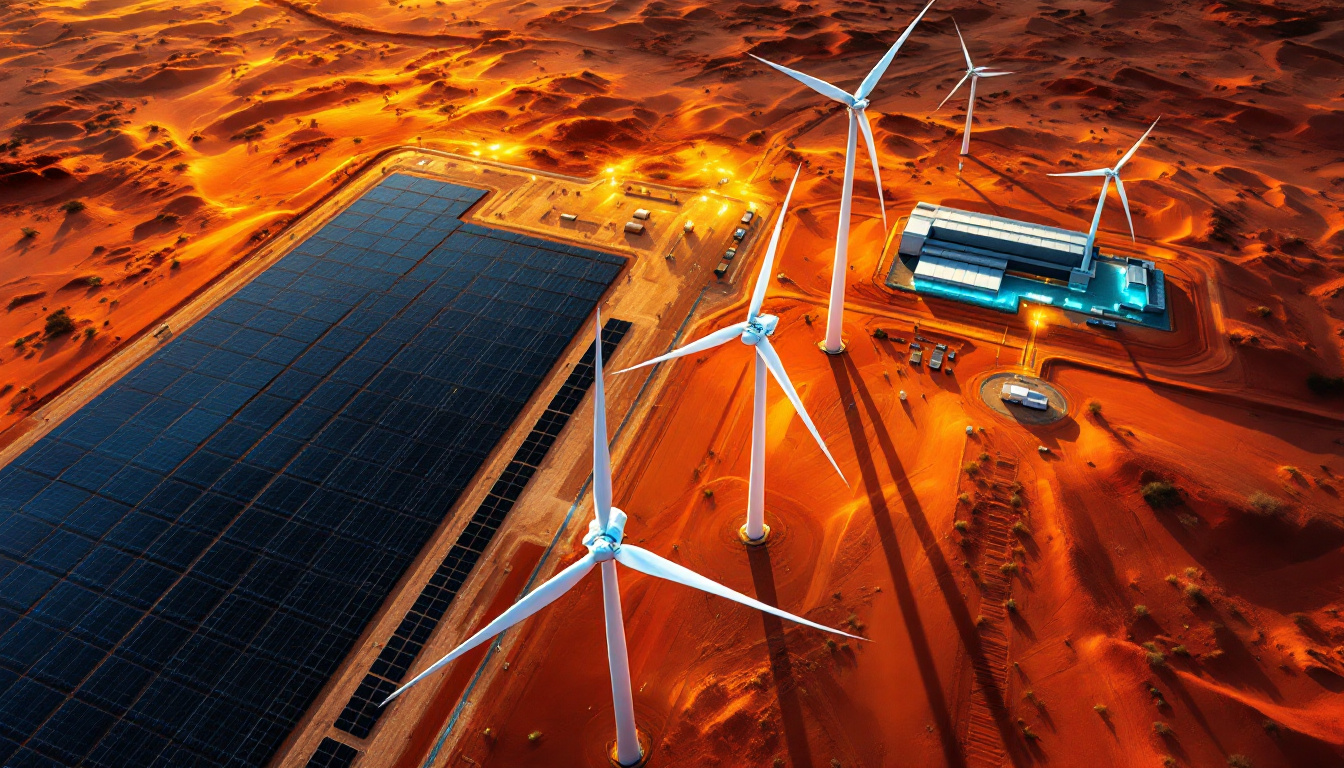What Makes South Australia Ideal for Green Iron Production?
South Australia stands as a global leader in renewable energy integration, achieving the remarkable feat of being recognized as the world's #1 jurisdiction for integrating wind and solar energy in a gigawatt-scale grid. This transformation has been nothing short of revolutionary, with renewable energy growing from a mere 1% to an impressive 74% in just 17 years.
The state's progressive energy policy is highlighted by its early coal exit in 2016 and ambitious target of achieving 100% net renewable energy by 2027. According to the South Australian Department for Energy and Mining, "Our renewable energy transition is not just about environmental benefits—it's creating the foundation for entirely new industrial opportunities."
What truly sets South Australia apart is its unique geological advantage: 7.4 billion tons of economically demonstrated iron ore reserves, predominantly in the form of magnetite. This high-quality magnetite is distributed across three distinct provinces and features exceptional characteristics that make it particularly suitable for green steelmaking processes.
The extraordinary collocation of world-class renewable energy resources and vast magnetite deposits near existing infrastructure creates a competitive advantage that few other regions globally can match. As South Australia's Premier emphasized, "This is the opportunity of such immediate and unique proportions that it demands an all-in government effort."
How Does South Australian Green Iron Compare Economically to European Production?
A comprehensive joint study by the Port of Rotterdam and South Australian government revealed a compelling 20% cost advantage for producing Direct Reduced Iron (DRI) in Australia compared to European facilities. This economic edge stems primarily from avoiding the significant technical and financial challenges associated with hydrogen or ammonia transportation across long distances.
The study meticulously examined two production scenarios for comparison:
- DR production in South Australia with final steelmaking completed in Germany
- Complete production process conducted entirely in Germany
Using 2030 cost projections as a baseline, researchers analyzed plant scales of both 500,000 tons per year and 2.5 million tons per year to ensure robust conclusions across different operational sizes.
Perhaps most remarkable is that South Australia's economic advantage persists despite Europe's strong policy focus on localizing production. Industry experts suggest this stubborn cost differential highlights the fundamental geographic and resource advantages that South Australia possesses.
Energy economist Dr. Sarah Collins notes, "The economics simply favor production closer to where renewable energy and high-quality magnetite coexist. South Australia's advantage isn't policy-dependent—it's built on fundamental resource economics."
What Resources Support South Australia's Green Iron Ambitions?
South Australia's resource profile for green iron production is exceptional, starting with 18.8 billion tons of magnetite distributed across three distinct provinces, with 7.2 billion tons economically demonstrated and ready for development.
The quality of South Australian magnetite is particularly noteworthy. Geological assessments reveal that these deposits feature softer, coarser-grained material with significantly lower impurities compared to most global competitors. This superior quality reduces processing energy requirements and improves yield rates in direct reduction processes.
Renewable energy resources complement these mineral advantages, with wind resources achieving remarkable 55% capacity factors—significantly higher than global averages of 35-40%. Solar opportunities are equally impressive, delivering 70-75% capacity factors in optimal locations across the state.
The complementary nature of South Australia's wind and solar patterns provides a natural balancing effect, with solar generation peaking during daylight hours while wind generation typically strengthens during evening periods. This natural complementarity reduces energy storage requirements and improves overall system reliability.
Existing gas infrastructure with comprehensive pipeline connectivity provides a practical transition pathway, while the ambitious Northern Water Project—a $5 billion desalination plant with a 600km pipeline—addresses water supply concerns for large-scale industrial development.
The state also benefits from an existing industrial workforce in established smelter towns including Olympic Dam, Whyalla, and Port Pirie, providing a skilled labor foundation for new green iron facilities.
What Government Initiatives Support Green Iron Development?
South Australia has implemented a progressive regulatory framework to accelerate green iron development, anchored by the innovative Hydrogen and Renewable Energy Act that creates a streamlined "one-stop shop" approval pathway for major projects.
The government has already announced first release areas covering regions equivalent to half the size of Turkey, demonstrating the ambitious scale of its renewable energy vision. This is complemented by a government-led 250 megawatt electrolyzer project that will help establish early hydrogen supply chains.
The state has a proven history of innovation in renewable energy integration, exemplified by the globally recognized Tesla battery project that demonstrated South Australia's commitment to advanced energy solutions. This established track record provides confidence to potential investors in the green iron industry in South Australia.
Government representatives have consistently emphasized their "all-in government effort" backed by a "whatever it takes attitude" to ensure industry success. This is operationalized through a non-binding, non-competitive Expression of Interest (EOI) process designed to encourage maximum participation.
A senior government official explained, "We're committed to co-design and co-investigation approaches to industry establishment. Our focus is on complementing, not competing with, European steel production to create a win-win scenario for global decarbonization."
How Does the Expression of Interest Process Work?
The Expression of Interest process for South Australia's green iron industry launched on June 20, 2023, with submissions accepted until October 1, 2023. This non-binding, non-competitive market sounding exercise was specifically designed to initiate conversations and comprehensively assess opportunities without creating early winners and losers.
Outcomes from the EOI process will directly feed into de-risking studies beginning in 2025, creating a logical progression path for industry development. The submission process was intentionally designed to be straightforward, utilizing an accessible online portal to maximize participation.
The submission guide contains three primary sections:
- Company/consortium overview to understand participant capabilities
- Project details including scale, inputs/outputs, and infrastructure requirements
- Assessment of challenges, opportunities, and specific government support needed
Commercial sensitivity protections were explicitly built into the process, ensuring that proprietary information remains confidential. This encourages participants to share detailed plans without competitive concerns.
Industry consultant Michael Zhang, who advised several international participants, notes, "The EOI process strikes an effective balance between gathering necessary information and respecting commercial realities. It's designed to start meaningful conversations rather than force premature commitments."
What Technical Challenges Must Be Addressed?
While South Australia's green iron opportunity is compelling, several technical challenges must be acknowledged. Most fundamentally, hydrogen-based DRI remains an emerging technology without commercial-scale implementations globally. The shift to using 100% hydrogen as a reductant gas introduces several technical complications requiring innovative solutions.
A critical implementation challenge involves the congruent scaling of codependent industries—specifically hydrogen production and magnetite processing must develop in parallel to avoid supply-demand mismatches. This coordination complexity shouldn't be underestimated.
Transportation logistics present another consideration, particularly regarding dust formation concerns with magnetite pellets and Hot Briquetted Iron (HBI). Special handling and shipping protocols will be essential to maintain product integrity during export processes.
Water supply requirements for large-scale production are substantial, which underlies the strategic importance of the Northern Water Project. Additionally, the transition period will require gas supplies of approximately 15-30 petajoules while green hydrogen scales up to full capacity.
Electricity demand will be considerable, with industry estimates suggesting requirements of 7-10 terawatt-hours to support comprehensive green iron development. This represents a significant scaling challenge for the state's renewable energy sector.
Metallurgist Dr. Elena Koroleva explains, "The transition from natural gas to hydrogen in direct reduction involves more than simple substitution. We're seeing complex metallurgical interactions that require careful optimization at commercial scale. South Australia is well-positioned to solve these challenges, but acknowledging the technical complexity is essential."
What Are the Next Steps for Industry Participation?
Companies interested in South Australia's green iron opportunity should prioritize submitting an Expression of Interest by the October 1, 2023 deadline to ensure inclusion in initial development planning. Direct meetings with South Australian government representatives can provide valuable support and clarification throughout this process.
Participation in de-risking studies beginning in 2025 represents the next major milestone, with early participants gaining advantages in shaping infrastructure and policy development. Companies should also explore technology support available through the Heavy Industry Low-carbon Transition Cooperative Research Centre (HILT CRC), which offers specialized expertise in mining industry decarbonisation efforts.
For organizations seeking early market entry, demonstration-scale projects of 40-50,000 tons provide practical pathways with access to initial hydrogen supplies. These smaller initiatives can validate technologies while broader infrastructure develops.
The Premier has established a development timeline targeting 2030 for significant commercial operations, creating a clear horizon for investment planning. Companies can leverage multiple support mechanisms from both federal and state governments, including potential grants, tax incentives, and regulatory assistance.
As industry advisor Jessica Morgan observes, "Companies that engage early will help shape the ecosystem and secure optimal positions in what promises to be a significant new global value chain. The government's collaborative approach means industry input genuinely influences development pathways."
FAQ: Green Iron Industry in South Australia
Who can participate in the EOI process?
The process welcomes diverse participants including steel makers, technology providers, renewable energy developers, and industry partners at any project stage—even those still at the conceptual level. The non-competitive nature of the process encourages broad participation.
What support options are available from the South Australian government?
Rather than offering predetermined packages, the government is actively seeking industry input on specific needs to develop tailored support mechanisms. This co-design approach ensures support aligns with actual industry requirements.
What are the timeframes for industry development?
While the Premier has established a target of 2030 for significant operations, specific development timelines will be guided by industry needs and technological readiness. The government has emphasized flexibility in supporting different development pathways.
How can companies without Australian experience participate?
International companies are encouraged to submit through the EOI process and reach out for introductions to relevant local partners. The government has established support services specifically to assist international participants in navigating the Australian business environment.
What policy frameworks are being developed?
Key initiatives include the Hydrogen and Renewable Energy Act, comprehensive planning reforms, establishment of the office of Coordinator General, and petroleum legislation amendments to support transition activities. These frameworks are designed to streamline approvals while maintaining environmental protections.
Key Stakeholders and Partnerships
The green iron ecosystem in South Australia involves numerous important stakeholders, with the South Australian Department for Energy and Mining serving as the central coordinating agency. International partnerships are already forming, exemplified by the collaboration with the Port of Rotterdam to analyze supply chain economics.
The Australian Trade and Investment Commission provides valuable support for international participants seeking entry into the Australian market. Existing industry players—including BHP Olympic Dam, Liberty Steel Whyalla, and Trafigura/Nyrstar Port Pirie—represent potential partners with established industrial operations in the region.
Several companies are already advancing hydrogen projects that could supply green iron facilities, including Atco, BOC/Linde, and Epic Energy. Research support is available through the Heavy Industry Low-carbon Transition CRC (HILT CRC) and Adelaide University, which offers specialized expertise in renewable energy integration and metallurgy.
Industry collaboration specialist Robert Chen emphasizes, "The green iron industry in South Australia requires an ecosystem approach—no single organization can deliver the complete solution. South Australia's advantage includes not just resources, but a collaborative industrial culture that supports complex supply chain development."
The state's approach aligns with broader efforts in mining's crucial and paradoxical role in the clean energy transition, highlighting how traditional extractive industries can pivot toward sustainable practices. Furthermore, initiatives like BHP and HBIS' pioneering decarbonisation partnership in the steel industry demonstrate how international collaborations can accelerate progress toward low-carbon steel production.
South Australia's development of its green iron capabilities also benefits from federal support through programs like Australia's $2.5 million critical minerals grant driving innovation, which helps address technological barriers. Additionally, the state's approach addresses many of the challenges identified in transforming the mining industry: ESG challenges and global opportunities by creating clear pathways for sustainable resource development.
Want Early Alerts on Australia's Next Major Mineral Discoveries?
Gain an immediate edge in ASX resource investments with Discovery Alert's proprietary Discovery IQ model, which provides instant notifications about significant mineral discoveries before the broader market. Visit our discoveries page to see how past discoveries have generated exceptional returns and start your 30-day free trial today.




